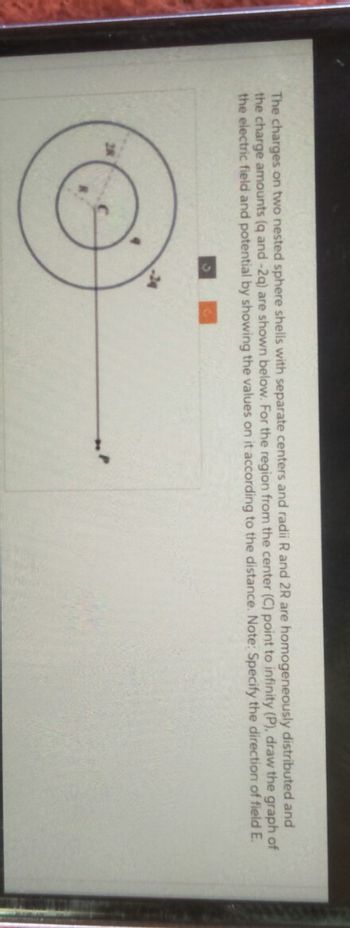Question

Transcribed Image Text:The charges on two nested sphere shells with separate centers and radii R and 2R are homogeneously distributed and
the charge amounts (q and -2q) are shown below. For the region from the center (C) point to infinity (P), draw the graph of
the electric field and potential by showing the values on it according to the distance. Note: Specify the direction of field E.
Expert Solution
This question has been solved!
Explore an expertly crafted, step-by-step solution for a thorough understanding of key concepts.
This is a popular solution
Trending nowThis is a popular solution!
Step by stepSolved in 3 steps with 1 images

Knowledge Booster
Similar questions
- Which one of the following statements best describes the equipotential surfaces surrounding a point charge? O The equipotential surfaces are concentric spheres with the charge at the center. O The equipotential surfaces are curved planes surrounding the charge, but only one passes through the charge. O The equipotential surfaces are concentric cylinders with the charge on the axis at the center. The equipotential surfaces are planes extending radially outward from the charge. O The equipotential surfaces are concentric cubes with the charge at the center.arrow_forwardPlease help with a, b and carrow_forwardFigures in Fig. 1 above illustrate the electric field and potential as a function of distance from the surface of a charged conducting sphere. What is the main difference between electric field and electric potential for a solid charged conducting sphere?arrow_forward
- Needs Complete typed solution with 100 % accuracy. Don't use chat gpt or ai i definitely upvote you.arrow_forwardA parallel-plate capacitor has a charge Q and plate separation d, as shown below. We assume that the size of plates is much larger than the separation d. Each particle is initially at rest and then released, allowing it to accelerate. Assuming each particle has the same mass, rank the speeds of the particles when they impact the left plate. 1. A parallel-plate capacitor has a charge Q and plate separation d, as shown below. We assume that the size of plates is much larger than the separation d. Rank the force that each particle feels at its given position within the capacitor. E>D=C>A=B D>E>B=C>A D>B>E>C>A A>E>C>D>B E>A=C>D=B 2. A parallel-plate capacitor has a charge Q and plate separation d, as shown below. We assume that the size of plates is much larger than the separation d. Each particle is initially at rest and then released, allowing it to accelerate. Assuming each particle has the same mass, rank the speeds of the…arrow_forwardPlease read the question and leave notes on the answer where appropriate. Please DO NOT skip any steps. Please double check your answer. Please do not type out a response. Please use LaTeX or use a hand written response that is LEGABLE. Please review your answer to make sure all steps are clearly visable. Please double check your work. Thank you.arrow_forward
arrow_back_ios
arrow_forward_ios